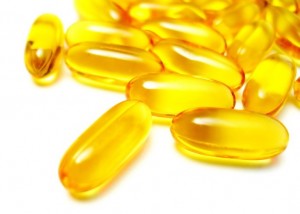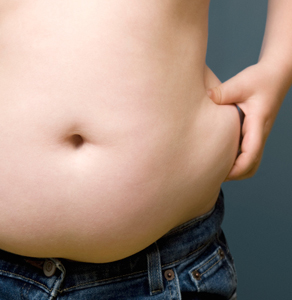By George L. Redmon PH.D.
Make It Rain Anabolically With Vitamin D
Unwavering literature indicates that physical and athletic performance peaks when 25-hydroxy-vitamin D [25(OH) D] levels peak, declines as they decline, and reaches its nadir (rock bottom) when 25(OH) D levels are at their lowest point. Vitamin D also increases the size and number of Type II (fast twitch) muscle fibers. However, accumulated data indicates that peak athletic performance occurs when 25(OH) D levels approach those obtained by natural, full-body, summer sun exposure, which is at least 50 ng x mL (-1). Dr. John Cannell, M.D. Medicine and Science in Sports and Exercise
Over the last several decades researchers have discover a definitive link to a deficiency of Vitamin D as a causative factor in the development of a host of bone and skeletal matrix disorders. What has been more problematic from the standpoint of public health officials is the enormous  amount of studies highlighting the pleomorphic effects (ability to take on different forms) of vitamin D outside its conventional role in calcium and bone homeostasis. A case in point, current data indicates that vitamin D also plays a key role in regulating many physiological parameters that prevent cancer, diabetes, enhances immunity, the down-regulation of autoimmune diseases, respiratory and prostate dysfunction, to promoting a healthy pregnancy and aging. Vitamin D also assists in modulating the actions of various organs including the heart, lungs, adrenal glands, pituitary gland brain and the brain. However, more compelling concerning “D’s”
amount of studies highlighting the pleomorphic effects (ability to take on different forms) of vitamin D outside its conventional role in calcium and bone homeostasis. A case in point, current data indicates that vitamin D also plays a key role in regulating many physiological parameters that prevent cancer, diabetes, enhances immunity, the down-regulation of autoimmune diseases, respiratory and prostate dysfunction, to promoting a healthy pregnancy and aging. Vitamin D also assists in modulating the actions of various organs including the heart, lungs, adrenal glands, pituitary gland brain and the brain. However, more compelling concerning “D’s”
Pleomorphic effect is that of serving as the molecular ignition- switch that triggers gene transcription. This process is the first step in the formation of specific sequences of DNA/RNA based proteins composed of many genes that regulate the actions of a multitude of other proteins. This from a chemical standpoint is not only anabolic equilibrium in motion, but life itself, hence “D” tag as having a pleomorphic effect by the health community.
The Dosing Problem
The major problem here cited by public health officials has been determining correct dosages for all of these parameters and the sun’s role in the natural manufacture of 25-hydroxy-vitamin D [25(OH)D]. Incidentally, researchers now know that the human body makes 90% of its vitamin D naturally from sunlight, specifically from ultraviolet B exposure to the skin. The process starts when a form of cholesterol called 7-dehydrocholesterol (7-DHC), naturally found in your skin, absorbs the UVB radiation and gets converted by a pro-hormone in the skin into cholecalciferol (D3). Despite this naturally occurring process researchers at the Mater Hospital in Australia state that many individuals are deficient in vitamin D, but haven’t gotten or clearly understand the defensive posture “D” puts them in with regards to sustaining a healthy and fit internal environment. This is evidenced by the fact that researchers estimate that over one billion people around the globe are deficient in vitamin D. Here in the US accumulated data indicates that 64% of the American populations don’t have enough “D” to keep all their tissues functioning at peak capacity. Conversely, when you review the comments above by Dr. John Cannell M.D., a nationally known vitamin D expert and founder of the Vitamin D Council, they imply that vitamin D has the same pleomorphic effect on a variety of anabolic parameters.
a pro-hormone in the skin into cholecalciferol (D3). Despite this naturally occurring process researchers at the Mater Hospital in Australia state that many individuals are deficient in vitamin D, but haven’t gotten or clearly understand the defensive posture “D” puts them in with regards to sustaining a healthy and fit internal environment. This is evidenced by the fact that researchers estimate that over one billion people around the globe are deficient in vitamin D. Here in the US accumulated data indicates that 64% of the American populations don’t have enough “D” to keep all their tissues functioning at peak capacity. Conversely, when you review the comments above by Dr. John Cannell M.D., a nationally known vitamin D expert and founder of the Vitamin D Council, they imply that vitamin D has the same pleomorphic effect on a variety of anabolic parameters.
Same Patterns of Deficiency
Paradoxically, sports medicine researchers have found that the anabolic pleomorphic effect and correct dose ranges also appears to be a problem with athletes, fitness enthusiast and individuals engaged in resistance training. For example, although unanticipated, 77% of German gymnasts were found to have 25(OH) D levels below 35 ng/mL and 37% had levels below 10 ng/mL. A study of Finnish female athletes found 67% with levels below 15 ng/mL. Regrettably, American athletes have also shown to have low blood levels of D similar to the general US population. Part of the problem here according to Dr. Anthony Norman, Ph.D. at the Department of Biochemistry at the University of California who is internationally recognized as a key researcher whose discoveries shaped what is known today about vitamin D is that the daily recommended dose of 200-400iu’s( international units) set decades ago is outdated based on current knowledge.
The Steroid Effect of “D”: The “D” Receptor Discovery
While not advertised as such, because of its chemical structure and overall function in the body, many researchers contend that vitamin D should have been classified as a steroid hormone some decades ago (1932), when it was revealed that vitamin D was a precursor of a new steroid hormone, classified chemically as 1alpha, 25 (OH)2-vitamin D3 [1alpha,25(OH)2D3]. The fact is as cited by researchers at the Department of Pharmacology at Case Western Reserve University in Ohio, although officially classified as a vitamin,  the active form of vitamin D (D3) is actually a steroid hormone with similar traits as other steroid hormones. This is evidenced by the discovery of what researchers refer to as vitamin D’s own individual endocrine system , defined by the presence of vitamin D receptors in just about every tissue, cell type and organ within the human body. As a note here, the endocrine system is composed of different glands that all secrete different types of hormones directly into the bloodstream.
the active form of vitamin D (D3) is actually a steroid hormone with similar traits as other steroid hormones. This is evidenced by the discovery of what researchers refer to as vitamin D’s own individual endocrine system , defined by the presence of vitamin D receptors in just about every tissue, cell type and organ within the human body. As a note here, the endocrine system is composed of different glands that all secrete different types of hormones directly into the bloodstream.
Equally, researchers at the Washington University School of Medicine state that because of vitamin D’s own built in endocrine system and its ability to stimulate induction of cell differentiation, inhibit cell growth, modulate the immune surveillance system, control other hormonal systems and regulate transcription (the first step in carrying out genetic instructions in living cells) that its anabolic/ life extension potential has been grossly underestimated and misunderstood. Consequently, these physiological discoveries have prompted sports medicine researchers to examine the link between vitamin D deficiency and its impact on individuals engaged in resistance training.
In the next section below we will review what the science is telling us that vitamin D does to down-regulate and or inhibit those nasty catabolic chemicals and processes that seek to destroy muscle tissue, disrupt recovery and the body’s internal anabolic equilibrium.
Making It Rain Anabolically With D
*D Inhibits Fat Accumulation– in a recent study to validate the presumption that vitamin D inhibits the accumulation of fats, Iranian researchers studied the impact of D3 in 72 overweight women. The experimental group supplemented 1000 IU’s of vitamin D3 per day versus the placebo group. The experimental  group’s vitamin D3 levels rose to almost 40ng/ml of blood over the course of 12 weeks paralleled by a 2.7% loss of body-fat and a1.8% gain of body mass. The placebo group only lost 0.5 % fat mass and gained 0.4 % lean body mass. Conversely, researchers at the University of Southern California found that there is a definitive link between low blood levels (24ng to 29ng/ml) of Vitamin D and accelerated fat accumulation in muscles, which eventually lead to significant reductions in muscle strength and performance. What was alarming about this study was the participants who were young vibrant females in their prime (age range 16-22) who lived a sunny warm climate. This study underscored the importance of supplementation/diet along with sun expose to fill in the missing gaps.
group’s vitamin D3 levels rose to almost 40ng/ml of blood over the course of 12 weeks paralleled by a 2.7% loss of body-fat and a1.8% gain of body mass. The placebo group only lost 0.5 % fat mass and gained 0.4 % lean body mass. Conversely, researchers at the University of Southern California found that there is a definitive link between low blood levels (24ng to 29ng/ml) of Vitamin D and accelerated fat accumulation in muscles, which eventually lead to significant reductions in muscle strength and performance. What was alarming about this study was the participants who were young vibrant females in their prime (age range 16-22) who lived a sunny warm climate. This study underscored the importance of supplementation/diet along with sun expose to fill in the missing gaps.
*D and Insulin Growth Factor-1- a new study presented in the scientific journal Molecular Cell Biology revealed that via the interaction of several co-factors in combination with the VDR receptors, when down-regulated in the absence of vitamin D3, heightens the transcriptional expression of the antagonistic hormone IGFBP-3 which unfortunately accelerates the disposal of IGF-1 (insulin growth factor-1). This negative feedback process can derail your ability to reach your full anabolic potential as IGF-1 is a growth factor which is very closely related to insulin and regulates the anabolic attributes of growth hormone( increased fat-burning, lean muscle development, muscle repair, increased protein synthesis, etc.) when it is secreted into the bloodstream.
Vitamin D3: A Natural Aromatizing Agent
Interestingly, in a hormone related study appearing in the journal Hormone and Metabolic Research, vitamin D interacting with VDR receptors on reproductive glands was found to decrease the aromatizing or conversion activity of testosterone (one of your most anabolic hormones) to estrogen. However, more surprisingly researchers at Stanford University recently reported that the anti-estrogenic effect of vitamin D is expressed mostly in fat tissue and was found to be as effective as the estrogen-blocking drugs arimidex, letrozole and exemestane that are widely used among medical professionals in treating certain cancers. Furthermore, in a related study appearing in Clinical Endocrinology researchers looking at the ability of Vitamin D to act as a steroid like testosterone in 1362 males reported that there is a definitive link between adequate levels of vitamin D and rising total and free testosterone levels.
*D Reduces Muscle Damage: it is a well-known fact that after intense workouts, elevated levels of pro-inflammatory compounds called cytokines increase and accelerate muscle damage, fatigue and poor recovery. In a current study appearing in the journal Cytokine binding of the active vitamin D metabolite 1,25(OH)(2)D(3) to vitamin D receptor (VDR) dramatically reduced the inflammatory markers, creatine kinase and lactate dehydrogenase that are normally elevated in the muscle following an workout. Conversely, researchers at the Department of Medicine and Bioregulatory Sciences at the University of Tokushima in Japan, discovered from muscle biopsy studies that prolonged Vitamin D deficiency caused atrophy( wasting away) of type 2 muscular fibers.
In a current study appearing in the journal Cytokine binding of the active vitamin D metabolite 1,25(OH)(2)D(3) to vitamin D receptor (VDR) dramatically reduced the inflammatory markers, creatine kinase and lactate dehydrogenase that are normally elevated in the muscle following an workout. Conversely, researchers at the Department of Medicine and Bioregulatory Sciences at the University of Tokushima in Japan, discovered from muscle biopsy studies that prolonged Vitamin D deficiency caused atrophy( wasting away) of type 2 muscular fibers.
Furthermore, in a related study, researchers at the American Orthopaedic Society for Sports Medicine researchers reported that vitamin D plays a key role in minimizing the incidence of common musculoskeletal injuries seen in other athletic events, especially within the National Football League (NFL). In fact current data has revealed that professional football players with average blood levels of D3 at19.9 ng/ml were found to be more susceptible to injury.
Please Note: For individuals involved with resistance training or general fitness for that matter, this is a very critical point, as current data has definitively shown that when vitamin D levels are low, vitamin D receptor expression( instructions and signals from hormones, molecules, nutrients, etc.) in human muscle tissue decreases and at a more rapid rate with age.
*D Enhances Muscle Energetics – recently researchers at Newcastle University in England reported that vitamin D3 (cholecalciferol) improved the size and strength of muscle fibers via its impact on what researchers refer to as phosphocreatine recovery kinetics. In this process creatine attaches to phosphate and it is jacked with a rapidly moving reserve of energy within skeletal muscle tissue to make more ATP. This renewed energy current is used to power the movement of the myosin heads in the muscle that are responsible for muscle contraction. Paradoxically, these researchers also found that subjects deficient in vitamin D when administered cholecalciferol – D3 for 12 wks had a significant reduction in phosphocreatine turnover and recover time. They found improvement in the end power of ATP to its regeneration via the biochemical activation of the phosphocreatine phosphorylation cascade from 34.4 seconds to 27.8 seconds.
Please Note: while this bump seems small in stature, chemically it’s beyond extraordinary since ATP is only sufficient for 1-2 seconds of activity as a direct energy source for working muscles and phosphocreatine 5-8 seconds as a secondary energy source. This process known as an anaerobic one (without oxygen), is the source of energy your muscles use for those short- power packed lifts. This rapid turn-over of ATP added by “D3” in fast twitch fibers is an asset to resistance training individuals due to the need to quickly generate a lot of force.
r*D Improves Muscle Strength – for decade’s researchers knew that “D” enhanced muscle strength, physical performance and muscle fiber composition from clinical trials, but couldn’t quite explain exactly how. While many mechanisms of action are unraveling, recently investigators at the Human Nutrition Research Center on Aging at Tufts University in Washington reported that via receptors present in muscle cells when interlocked with D3, as muscle damage occurs results in changes in gene transcription ( instructions ) given to mRNA ( messenger-RNA proteins). That message, accelerate protein synthesis. Studies have shown that this action kick-starts enhanced cross-sectional hypertrophy (enlargement) of Type II muscle fibers and results in increased muscle strength. As you know, these guys are called the anaerobic fibers, being stronger and more powerful than type 1 muscle fibers.
Comparable studies indicate that this VDR interaction with D also increases Type II muscle fibers in number, size and reduces injuries in athletes. In fact researchers at Department of Gerontology and Musculoskeletal Sciences at Galliera Hospital (Genoa, Italy) reported that muscle tissue receptors have a high affinity or attraction for 1,25-dihydroxyVitamin D [1,25(OH)2D], the active form of Vitamin D. However, the presence of a non-functioning Vitamin D receptor (VDR) caused poor development of muscle fibers with diameters about 20% smaller.
*D Enhances Protein Synthesis – in a interesting study conducted at The Orthopedic Specialty Hospital in Salt Lake City, UT, researchers reported that subjects who had higher vitamin D levels had faster rates of recovery following intense workouts. These researchers recruited fourteen physically active adults who performed intense exercise with one leg while the other leg acted as a control. Their strength was tested at day one, two, three and seven following the initial exercise routine. By assessing the amount of strength the one leg retained researchers could assess the initial muscle damage and time to recovery. The group with higher levels of vitamin D in their blood were able to regain their strength quicker. Based on their data, these researchers concluded that vitamin D protects against muscular weakness caused by muscle damage due to its ability to regulate calcium and protein synthesis within the muscle, which plays a major role in the muscle’s contractibility.
Suggested Dose: 4000 to 6000 iu/d in its natural hormone form of cholecalciferol – D3. Vitamin D2 (ergocalciferol) is found in plants and the source found in fortified milk sources and some supplements. This form, vitamin D2 has been found to be less active in human tissue.
Conclusions
In retrospect, it is the steroid/ pleomorphic effect that distinguishes vitamin D’s superiority that enhance the resistance trainings individual’s ability to generate and sustain the body’s internal anabolic and fitness continuum. What is more amazing here is that there is no gender bias concerning this nutrient’s metabolic/anabolic and health potential? Unfortunately, it still remains one of the most underutilized and misunderstood steroid hormone/ vitamin supplements of all time. This however is quickly changing as the word now buzzing around the general fitness and resistance training community is that if you want to make it rain anabolically, you need to step up and bring not you’re A but D game.
George L. Redmon, Ph.D.
Dr. Redmon has been associated with the vitamin and health industry for over 25years, having served as The National Product and Education Director for one of the country’s largest retailers of nutritional supplements. He has been widely published in many major bodybuilding, fitness and alternative medicine publications. He is the author of
Natural Born Fat Burners, Energy for Life and is a member of The National Academy of Sports Medicine and The International Society of Sports Nutrition.
References
American Orthopaedic Society for Sports Medicine. Vitamin D lowers injury in NFL football players who suffer muscle injury, study suggest. Science Daily on line at: www.sciencedaily.com. Retrieved on 07-18-2014.
Armas, L.A., Hollis, B.W., et.al. Vitamin D is less effective than vitamin D3 in humans. Journal of Clinical Endocrinology. 2000 Nov; 89(11): 587-591.
Bikle, D.D. Vitamin D: newly discovered actions require reconsideration of physiologic requirements. Trends in Endocrinology and Metabolism. 2010 Jun; 21(6):375-384.
Bischoff-Ferrari, H.A., Borchers, M. et.al. Vitamin D receptor expression in human muscle tissue decreases with age. Journal of Bone and Mineral Research. 2004; 19: 265–269.
Bonevski, B, Bryant, J. et.al. The ABC’s of Vitamin D: A Qualitative Study of the Knowledge and Attitudes Regarding Vitamin D Deficiency amongst Selected Population Groups. Nutrients 2013; 5 (3): 915-927.
Bouillion, R., Venstuf, A. Vitamin D mitochondria and muscle. Journal of Clinical Endrocrinology and Metabolism. 2013 Mar; 98(3): 961-963.
Calvo, M.S., Whiting, S.J., Barton, C.N. Vitamin D intake: a global perspective of current status. Journal of Nutrition. 2005 Feb; 135 (2): 310–316.
Cannell, J.J., Hollis, B.W. et. al. Athletic performance and vitamin D. Medicine and Science in Sports and Exercise. 2009 May; 41(5):1102-10.
Ceglia, L. Vitamin D and skeletal muscle tissue and function. Molecular Aspects of Medicine. 2008 Dec; 29 (6):407-414.
Christakos, S., Hewison, M. et.al.Vitamin D: beyond bone. Annals of New York Academy of Sciences. 2013 May; 1287: 45-58.
Cooper, G.M. Actin, Myosin and Cell Movement. The Cell – NCBI Bookshelf. On line at: www.ncbi.nlm.nih.gov ›NCBI › Literature › Bookshelf. Accessed on: 07-19-14.
Dusso, A.S., Brown, A.J., Slatoplsky, E. Vitamin D. American Journal of Physiology and Renal Physiology. 2005 Jul; 289 (1):F8-28.
E. Carrillo, M.G., Flynn, C. et.al. Impact of vitamin D supplementation during resistance training intervention on body composition, muscle function and glucose tolerance in overweight and obese adults. Clinical Nutrition. 2012. Published ahead of print 20:16/j.cinu.
Endo I, Inoue D., et al. Deletion of vitamin D receptor gene in mice results in abnormal skeletal muscle development with deregulated expression of myoregulatory transcription factors. Endocrinology.2003; 144: 5138-5144.
Gilsanz, V. Kremer, A. et.al. Vitamin D Status and Its Relation to Muscle Mass and Muscle Fat in Young Women. Journal of Clinical Endocrinology and Metabolism. 2010; Apr; 95 (4):1595-1601.
Gomez, A. C., Naves, D.M. [Review of the concept of vitamin D “sufficiency and insufficiency”]. Nefrologia. 2003; 23 (Suppl 2):73-77.
Hamilton, B. Vitamin D and Athletic Performance: The Potential Role of Muscle Asian Journal of Sports Medicine; 2011; 2 (4): 211-219.
Holick, M.F. Sunlight and vitamin D for bone health and prevention of autoimmune diseases, cancers, and cardiovascular disease. The American Journal of Clinical Nutrition. 2004; 80 (6 Suppl): 1678S–1688S.
Holick. M, F. High prevalence of vitamin D inadequacy and implications for health. Mayo Clinic. Proceedings. 2006Mar; 81 (3): 353–73.
Holick, MF. Vitamin D Deficiency. New England Journal of Medicine. 2007July; 357;266-281.
Jordon, A.N., Jurca, R., et.al. Effects of oral ATP supplementation on anaerobic power and muscular strength. Medicine and Science in Sports. 2004 Jun; 36 (6): 983-990.
Krishnan, A.V., Swami, S. et.al. Tissue-Selective Regulation of Aromatase Expression by Calcitriol: Implications for Breast Cancer Therapy. Endocrinology. January 1, 2010 Jan; 151 (1): 32-42.
Liao L, Chen X, Wang S, Parlow A, Xu J. Steroid receptor coactivator 3 maintains circulating insulin-like growth factor 1 (IGF-1) by controlling IGF-binding protein 3 expression. Molecular and Cellular Biology. 2008 Apr; 28:2460–2469.
Mosekilde, L. Vitamin D requirement and setting recommendation levels: long-term
Nimptsch, K., Platz, E.A. et.al Association between Plasma 25-OH Vitamin D and Testosterone Levels in Men. Clinical Endocrinology. 2012; 77(1):106-112.
Norman, A.W. From vitamin D to hormone D: fundamentals of the vitamin D endocrine system essential for good health. American Journal of Clinical Nutrition. 2008 Aug; 88(2):491S-499S.
Norman, A.W. Minireview: vitamin D receptor: new assignments for an already busy receptor. Endocrinology. 2006 Dec; 147(12):5542-55428.
Norman, A.W., Bouillon, R. Vitamin D nutritional policy needs a vision for the future. Experimental Biological and Medicine (Maywood) .2010 Sept; 235: (9):1034-1045.
Norman, A.W., Henry, H.L. et.al. Different shapes of the steroid hormone 1alpha,25(OH)(2)-vitamin D(3) act as agonists for two different receptors in the vitamin D endocrine system to mediate genomic and rapid responses. Steroids.2001 Mar-May; 66(3-5):147-58.
Pilz, S., Frisch, S., et al. Effect of Vitamin D Supplementation on Testosterone Levels in Men. Hormone and Metabolic Research. 2011; 43: 223-225.
Pioli, G, Giusti, A .The Inconsistent Data on the Effect of Vitamin D on Muscle Function. Journal of Spine. 2012; 1 (5):1000e107.
Salehpour, A., Hosseinpanah, F.A 12-week double-blind randomized clinical trial of vitamin D3 supplementation on body fat mass in healthy overweight and obese women. Nutrition Journal. 2012; 11:78.
Sherwood, L. Human Physiology: From Cells to Systems. Wadsworth Publishing: Belmont CA, 1997.
Sinhalin, A., Kieren, G. et.al. Improving the vitamin Status of vitamin D deficient adults is associated with improved mitochondrial oxidative function in skeletal muscle. Journal of Clinical Endocrinology and Metabolism. 2013Mar; 98(3): E509-E513.
Sutton. A.L., McDonald, P.N. Vitamin D: more than a bone-a-fide hormone. Molecular Endocrinology. 2003 May; 17(5):777-791.
The Voice of NETizen. Muscle, Fibersand Optimal Muscle Fatigue. Feb 3. 2012.On line at: thevoiceofnetizen.blogspot.com/2012/02/muscle-fibers-and-optimal… Accessed on 07-30-14.
Tortland, P,D. Vitamin D & Athletic Performance. On line at: www.jockdoctors.com/page.asp?id=49&name=Vitamin%20D%20&%20Athletic… Accessed on 07-27-14.
Wolf, G. The discovery of vitamin D: the contribution of Adolf Windaus. Journal of Nutrition. 2004June; 134 (6): 1299–1302.



